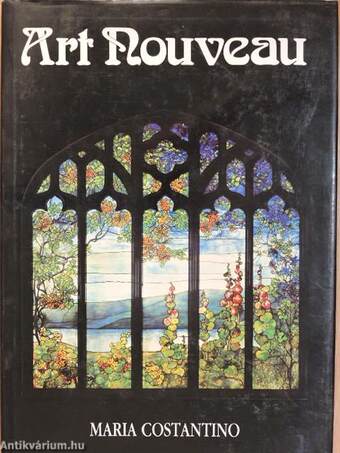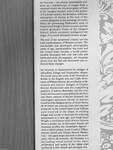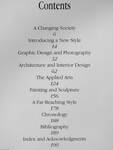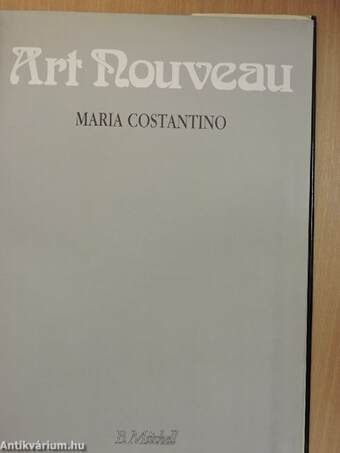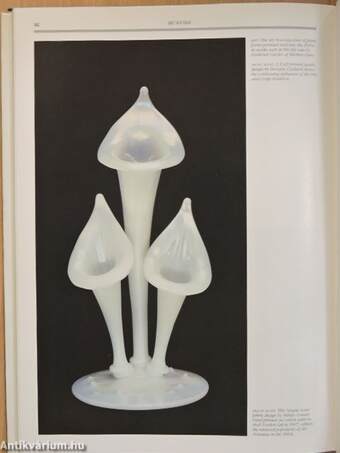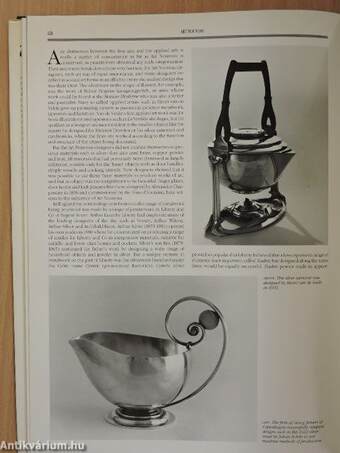1.067.317
kiadvánnyal nyújtjuk Magyarország legnagyobb antikvár könyv-kínálatát

VISSZA
A TETEJÉRE
JAVASLATOKÉszre-
vételek
Art Nouveau
| Kiadó: | W. H. Smith Publishers |
|---|---|
| Kiadás helye: | Kanada |
| Kiadás éve: | |
| Kötés típusa: | Fűzött keménykötés |
| Oldalszám: | 192 oldal |
| Sorozatcím: | |
| Kötetszám: | |
| Nyelv: | Angol |
| Méret: | 37 cm x 27 cm |
| ISBN: | 0-88665-591-9 |
| Megjegyzés: | Színes és fekete-fehér fotókkal, reprodukciókkal. |
naponta értesítjük a beérkező friss
kiadványokról
naponta értesítjük a beérkező friss
kiadványokról
Fülszöveg
Art Nouveau - the phrase immediately con-
jures up a kaleidoscope of images from a
vanished world: the frivolous gaiety of Paris
in the 'naughty nineties' seen in the posters
of Toulouse-Lautrec; the decadent, hothouse
atmosphere of Vienna at the turn of the
century glimpsed in the paintings of Gustav
Klimt; the pioneering Midwestern spirit of
Frank Lloyd Wright's Prairie houses; and the
austere geometric forms of the Glasgow
School, which uncannily prefigured the
shape of so much twentieth-century design.
The end of the nineteenth century saw the
total transformation of Western society. The
automobile was developed, photography
came of age, psychoanalysis was born and
the United States became a world power.
Lavishly illustrated with over 300 color and
black-and-white photographs, Art Nouveau
shows how the fine and decorative arts re-
flected these changes.
Art Nouveau is characterized by designs of
naturalistic foliage and biomorphic shapes.
The book traces... Tovább
Fülszöveg
Art Nouveau - the phrase immediately con-
jures up a kaleidoscope of images from a
vanished world: the frivolous gaiety of Paris
in the 'naughty nineties' seen in the posters
of Toulouse-Lautrec; the decadent, hothouse
atmosphere of Vienna at the turn of the
century glimpsed in the paintings of Gustav
Klimt; the pioneering Midwestern spirit of
Frank Lloyd Wright's Prairie houses; and the
austere geometric forms of the Glasgow
School, which uncannily prefigured the
shape of so much twentieth-century design.
The end of the nineteenth century saw the
total transformation of Western society. The
automobile was developed, photography
came of age, psychoanalysis was born and
the United States became a world power.
Lavishly illustrated with over 300 color and
black-and-white photographs, Art Nouveau
shows how the fine and decorative arts re-
flected these changes.
Art Nouveau is characterized by designs of
naturalistic foliage and biomorphic shapes.
The book traces the roots of Art Nouveau in
Britain to the English Arts and Crafts Move-
ment of William Morris, the rectilinear archi-
tectural and interior designs of Charles
Rennie Mackintosh and the compelling
graphics of Aubrey Beardsley. On the Con-
tinent Art Nouveau is exemplified by the Pari-
sian Metro stations of Hector Guimard, the
extravagant apartment blocks of Antonio
Gaudi and the Belgian stores of Victor Horta,
all of which use sinuous lines and exposed
ironwork. In the United States Louis Sullivan
used ironwork in the shape of swirling
foliage and scrolls to decorate his towering
monuments to a new age, and Frank Lloyd
Wright's rectilinear-style Prairie houses
show a similar use of decorative friezes. Art
Nouveau profiles the remarkable figures -
such as René Lalique, Louis Comfort Tiffany,
Antonio Gaudi and Charles Rennie Mackin-
tosh - who gave shape and style to the move-
ment. Above all, however, Art Nouveau is a
fascinating visual record of the sheer
exuberance and variety of the objets d'art
produced in this vibrant and energetic era. Vissza
Témakörök
- Idegennyelv > Idegennyelvű könyvek > Angol > Művészetek > Építészet
- Idegennyelv > Idegennyelvű könyvek > Angol > Művészetek > Festészet
- Idegennyelv > Idegennyelvű könyvek > Angol > Művészetek > Fotóművészet
- Idegennyelv > Idegennyelvű könyvek > Angol > Művészetek > Iparművészet
- Idegennyelv > Idegennyelvű könyvek > Angol > Művészetek > Szobrászat
- Művészetek > Művészettörténet általános > Társadalom és művészet > Egyéb
- Művészetek > Művészettörténet általános > Idegen nyelv > Angol
- Művészetek > Művészettörténet általános > Művészettörténet > Külföldi
- Művészetek > Művészettörténet általános > Korszakok, stílusok > XX. század > Egyéb
- Művészetek > Festészet > Korszakok, stílusok > XX. század > Szecesszió
- Művészetek > Festészet > Rajz, grafika > Története > Külföldi > Európai
- Művészetek > Festészet > Idegen nyelv > Angol
- Művészetek > Festészet > Általános festészet > Története
- Művészetek > Építészet > Korszakok, stílusok > XX. század > Szecesszió
- Művészetek > Építészet > Idegen nyelv > Angol
- Művészetek > Szobrászat > Korszakok > XX. század
- Művészetek > Szobrászat > Idegen nyelv > Angol
- Művészetek > Fotóművészet > Idegen nyelv > Angol
- Művészetek > Fotóművészet > Története > Külföldi
- Művészetek > Iparművészet > Formatervezés > Design
- Művészetek > Iparművészet > Idegen nyelv > Angol
- Művészetek > Építészet > Építészettörténet > Külföldi
- Művészetek > Iparművészet > Fém-, ötvösművészet > Egyéb
- Művészetek > Iparművészet > Bútor, lakberendezés > Lakásművészet
- Művészetek > Iparművészet > Bútor, lakberendezés > Stílusa
- Művészetek > Iparművészet > Kerámia, porcelán, üveg > Stílustörténet
Maria Costantino
Maria Costantino műveinek az Antikvarium.hu-n kapható vagy előjegyezhető listáját itt tekintheti meg: Maria Costantino könyvek, művekMegvásárolható példányok
Nincs megvásárolható példány
A könyv összes megrendelhető példánya elfogyott. Ha kívánja, előjegyezheti a könyvet, és amint a könyv egy újabb példánya elérhető lesz, értesítjük.



